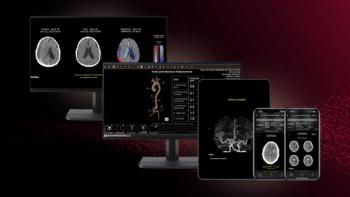
Speedy 64-slice CT assesses regional cardiac function
Current 64-slice CT scanners with improved temporal resolution enable detection of subtle regional changes in good correlation with clinical reference standards, according to a study presented this month at the annual meeting of the Society for Computed Body Tomography and Magnetic Resonance.
Polar map shows a subtle functional abnormality reliably detected at 64-slice CT in 63-year-old man with LAD infarction and dyskinesis (arrow) of the apex of the left ventricle, which bulges outward with cardiac contraction. The functional analysis (left) has good correlation with invasive ventriculography (right). (Provided by UJ Schoepf)
Current 64-slice CT scanners with improved temporal resolution enable detection of subtle regional changes in good correlation with clinical reference standards, according to a study presented this month at the annual meeting of the Society of Computed Body Tomography and Magnetic Resonance.
While MSCT's ability to assess global cardiac function is well documented, evaluation of regional wall motion is less well described. This investigation is one of the first evaluating both global and regional cardiac function parameters with MSCT, said lead author Matthias Kerl, a medical student at the Medical University of South Carolina.
Thirty patients with known coronary artery disease underwent gated SPECT and contrast-enhanced 64-slice coronary CT angiography. In 14 patients, transthoracic echocardiography (TTE) and cine-ventriculography were also performed. Correlation was calculated using Pearson's coefficient for multiple linear regression.
Global function measurements - end-systolic volume, end-diastolic volume, and ejection fraction - between all modalities were not statistically different. The best correlation was between CT and TTE, Kerl said.
Researchers analyzed regional wall motion by animated cine-loop models of the left ventricle and by 17-segment left ventricle polar plots of wall thickness, wall thickening, wall intensity, and segmental ejection fraction.
Gold standard SPECT showed 14 patients had abnormal left ventricle function. Correlation with CT was:
- r = 0.74 for the septal region
- 0.74 for lateral
- 0.92 for apical
- 0.74 for anterior
- 0.65 for inferior
Correlation between CT and TTE was:
- 0.77 for septal
- 0.67 for lateral
- 1.0 for apical
- 1.0 for anterior
- n/a inferior
CT correlation with ventriculography was:
- 1.0 for septal
- n/a lateral
- 0.88 for apical
- 0.27 for anterior
- n/a inferior
Overall correlation was 0.81 between CT and gated SPECT, 0.8 between CT and TTE, and 0.6 between CT and ventriculography.
"In this setting, CT is no different from the current clinical reference standards," senior author Dr. U. Joseph Schoepf, director of CT research at MUSC, told Diagnostic Imaging. "As long as coronary CTA is performed in a patient, there is no need to perform any other test."
Researchers' next step is to assess dedicated tools that facilitate comprehensive visualization of function and morphology based on CT.
For more information from the Diagnostic Imaging archives:
Newsletter
Stay at the forefront of radiology with the Diagnostic Imaging newsletter, delivering the latest news, clinical insights, and imaging advancements for today’s radiologists.




























